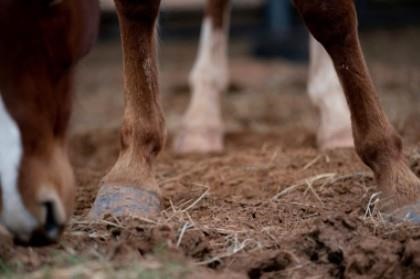By Kay Ledbetter
A common practice within the horse industry meant to strengthen the bones of mature horses could actually lead to bone breakdown in juvenile horses, according to a Texas A&M University Department of Animal Science in the College of Agriculture and Life Sciences research project.

Concerns are growing over off-label use of bisphosphonates within the horse industry.
Jessica Leatherwood, Ph.D., assistant professor of equine science, is joining with Tom Welsh, Ph.D., professor of physiology and reproduction and Texas A&M AgriLife Research Faculty Fellow with a dual appointment in the College of Veterinary Medicine and Biomedical Sciences; Kati Glass and Carolyn Arnold, both in Texas A&M’s College of Veterinary Medicine’s Large Animal Clinical Services; Amanda Bradbery, Ph.D., Montana State University; and faculty at Michigan State University to examine the effects of bisphosphonates in young horses.
Despite an overall decrease in racing fatalities over the past 10 years, California, Kentucky and New York documented an increase in racing fatalities in 2018, Leatherwood said. Manufacturers of the drug are equally concerned about the off-label use of bisphosphonates to mask vulnerability in the developing skeleton of juvenile horses.
Bisphosphonate use in juvenile, exercising horses could result in greater risk of death for horses and humans, and to the eventual elimination of racing and the jobs surrounding the industry, she said. Despite the recognition of off-label bisphosphonate use by racing commissions, testing capabilities to reliably regulate off-label bisphosphonate use are limited due to the drug’s affinity for bone, rapid clearance from circulation, and long-term effects on bone resorption, the researchers stated.
“Controversy surrounding the off-label use of bisphosphonates is becoming more widespread in the equine industry, especially following the recent spike in breakdowns and fatalities on the racetrack,” Leatherwood said. “In addition, bisphosphonates have been heavily marketed in other disciplines that focus on the young performance horse. While concerns have been raised, there is currently no scientific knowledge of the effects of bisphosphonate utilization in young exercising horses, which leaves a critical gap in the knowledge.”

Jessica Leatherwood, Ph.D., will lead a study to examine the effects of off-label use of bisphosphonates in young horses.
Their study, Bisphosphonate Pharmacokinetics and Comprehensive Effects on Juvenile Cartilage, Bone Growth and Healing: Implications for Animal Welfare, has been provided a $500,000 grant from the U.S. Department of Agriculture’s National Institute of Food and Agriculture.
“The Department of Animal Science is proud of Dr. Leatherwood and her team to elucidate the impacts of bisphosphonate risk in young horses,” said Cliff Lamb, Ph.D., department head, Bryan-College Station. “This work will inform our knowledge in the areas of administration effects on bone mass or bone turnover.”
What’s at stake
One type of bisphosphonates, clodronate disodium, was chosen as the bisphosphonate for this study because of its popularity and ease of administration. It, along with others, are not approved for use in young horses. Other bisphosphonates are labeled for use in horses over 4 years of age to treat degenerative bone disorders, Leatherwood said.
“Bisphosphonates are used to treat osteoporosis and similar diseases that cause the loss of bone density in humans as well as animals,” she said. “However, these drugs are used extensively ‘off-label’ in all ages of horses, and our particular concern is for the off-label use in the juvenile horse.”

Bone formation in young horses is of concern when bisphosphonates are used.
Leatherwood said the use in young horses is to potentially enhance bone formation and manipulate bone development to hide any skeletal pathologies.
“Young horses who will enter into early performance careers or race training are often placed in intensive management programs and sold early in life, and buyers often request radiographs prior to purchase to confirm skeletal health,” she said. “However, attempts to promote early bone maturation and mask potential radiographic flaws may lead to an accumulation of microdamage, which may eventually lead to bone failure due to lack of appropriate remodeling.”
Concern over the use of bisphosphonates across Europe and the U.S. in horse racing led to some regional regulations being enacted. However, concern goes beyond racing, into other performance disciplines where the use of bisphosphonates is heavily marketed.
The Fédération Equestre Internationale has banned the use of nitrogen-containing bisphosphonates – alendronate, ibandronate, neridronate, olpadronate, pamidronate, residronate and zoledronate – and has placed restrictions on the use of non-nitrogenous bisphosphonates – clodronate and tilduronate.
Due to a recent rule change, the U.S. Equestrian Federation now allows the use of bisphosphonates, but only in horses 4 years of age and older. This rule still leaves a large number of disciplines unregulated.
“Banned substances should not be used in competition horses at any time, and controlled substances may be used to enhance performance, so they are regulated,” Leatherwood said.
Additionally, she said, testing for bisphosphonates is challenging and not yet well-defined, because bisphosphonates rapidly clear from the blood and urine and have a strong affinity to bind to bone.
Using research to find answers
The Texas A&M study is designed to determine the wide-ranging effects of bisphosphonate administration in healthy, skeletally immature horses with specific regard to horses undergoing sales preparation and early exercise training.
The researchers state there is known off-label use in skeletally immature horses in an effort to prioritize bone formation and early maturation, and for potential analgesic effects, regardless of long-term implications. Osteoclastic activity is necessary for normal bone development and remodeling; therefore, osteoclast inhibition in healthy, skeletally immature horses will have significantly detrimental effects.
This study outlines a rigorous and comprehensive assessment of the effects of clodronate on skeletally immature animals subjected to exercise by investigating the effects on bone turnover, bone strength, bone healing, bone architecture, articular cartilage metabolism and joint analgesia.
“The effects of these drugs have not been tested in horses of this age, as there are no studies that have provided a detailed evaluation of the administration effects on bone mass or bone turnover,” Leatherwood said. “We are concerned this practice may lead to an alteration in bone remodeling, healing or growth that may result in a significant risk of maladaptation, lameness or ultimately may contribute to the early breakdown of young horses, which, beyond being a major concern for animal welfare, may also put the health and safety of jockeys in danger.”
Leatherwood said they will utilize a horse and sheep model to determine the drug’s effects on bone and joint health in young horses undergoing exercise. The use of sheep as a model allows for further understanding of the physiological and biomechanical effects of bisphosphonates in young animals.
“The sheep study allows for greater insight into changes in bone morphology and biomechanical properties,” she said. “Sheep are typically processed under the age of 2, so this allows for a deeper mechanistic understanding, which is not a feasible option in the horse.”
Specifically, Leatherwood said, her doctoral student Brittany Silvers will be gathering data on how quickly the bisphosphonate is cleared from the bloodstream. This will allow them to determine the duration of influence on bone development and the influence the drug has on inflamed cartilage metabolism.
“We expect that younger animals will clear bisphosphonates from their system faster than adult horses, that bone development will be altered in the young, exercising horse, and that bisphosphonates will have anti-inflammatory effects in the joint,” she said.
Leatherwood said the knowledge they gain could be used as a basis for any new regulatory policies on the use of bisphosphonates in young horses.
Source : tamu.edu